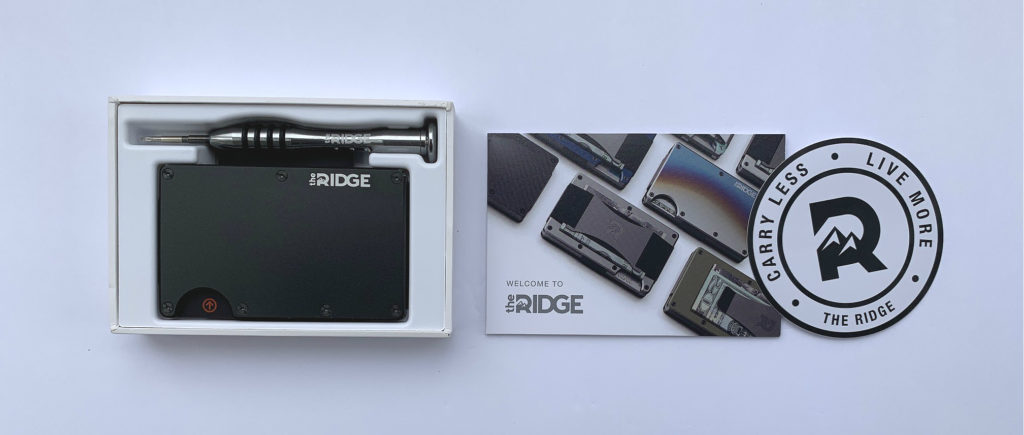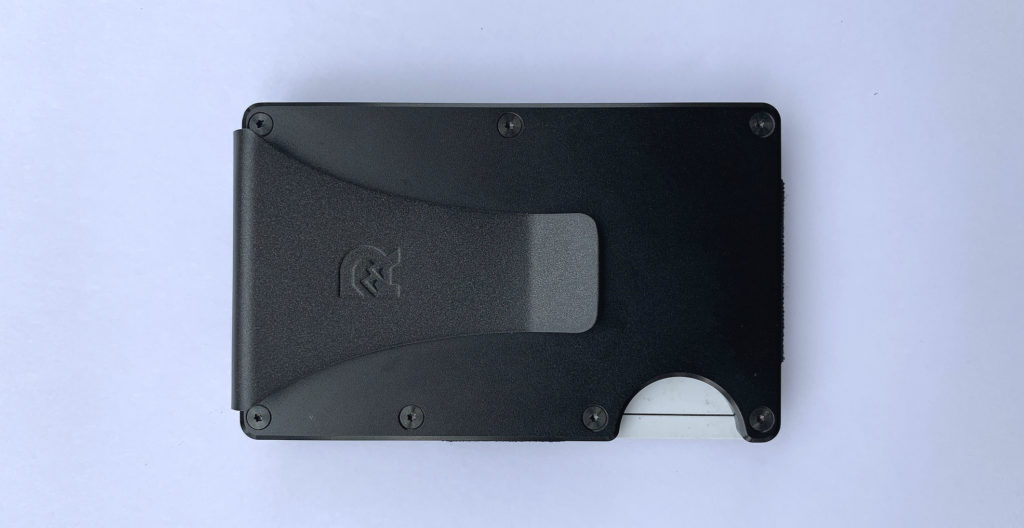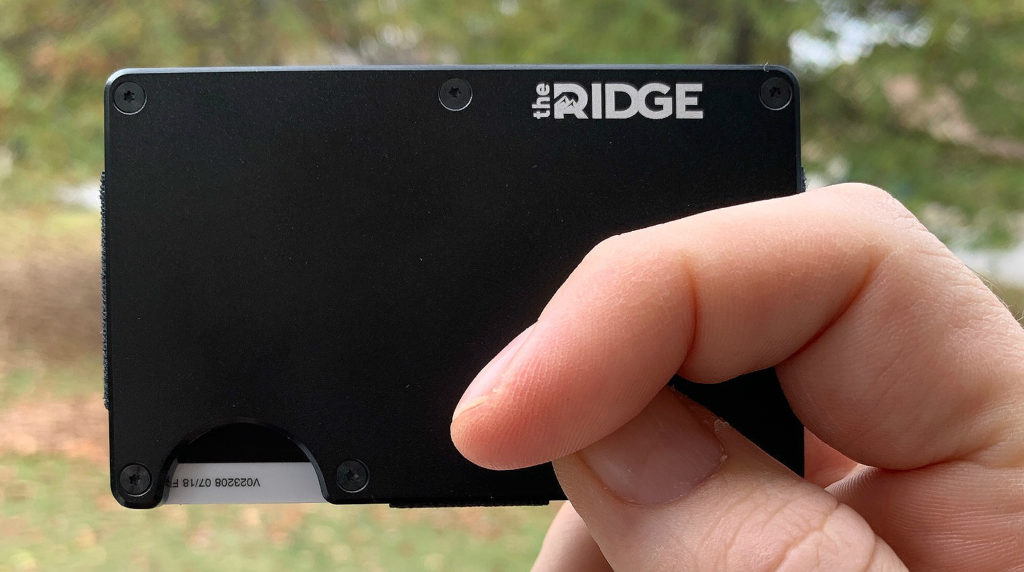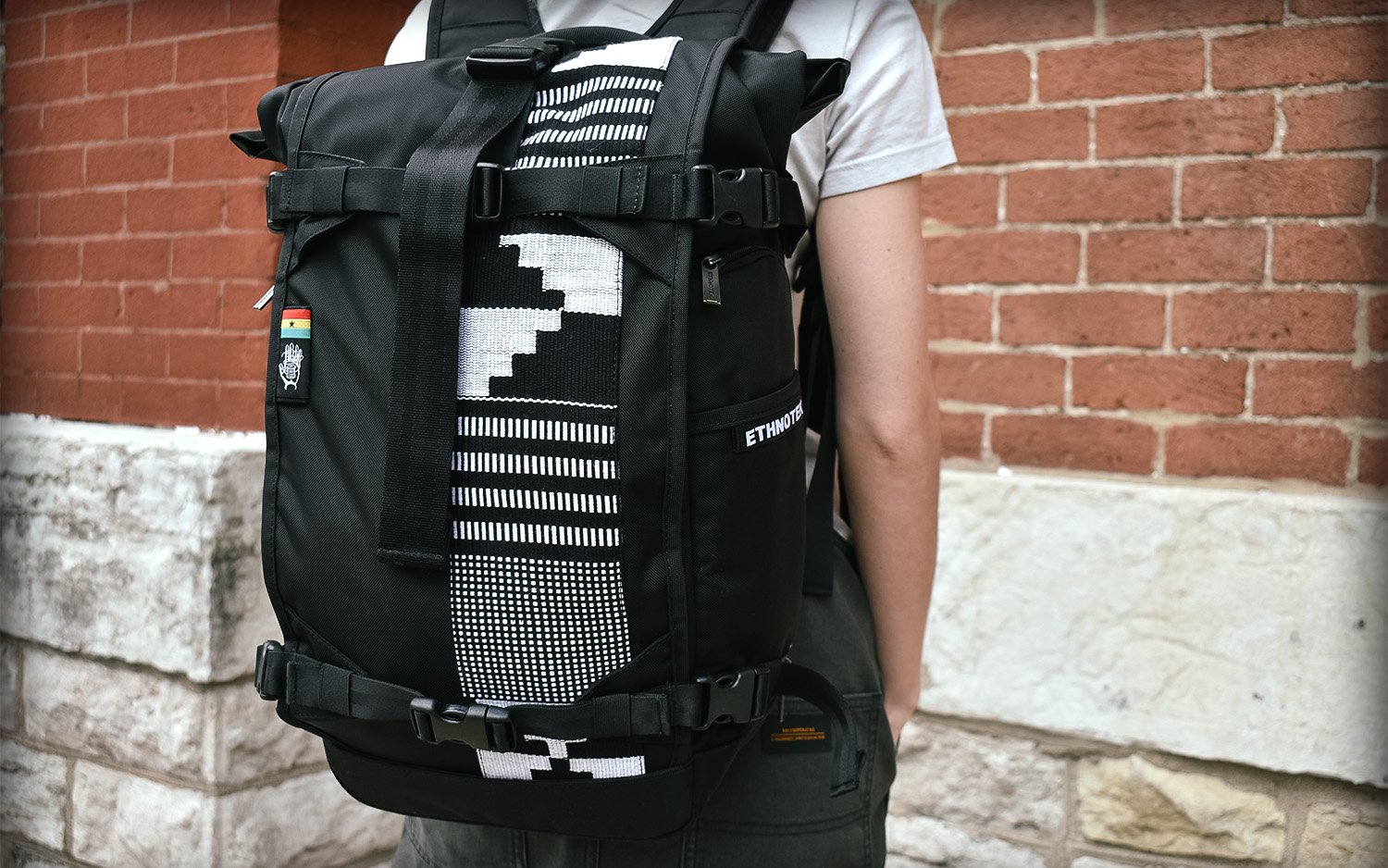Here at GearMoose, we jumped on the minimalist wallet train (many) years ago. Not only does it take up less space on your person, a minimalist wallet forces you to prioritize, getting rid of the detritus you might otherwise carry around. And when you get one that’s well constructed, it could very well be the last wallet you have to buy.
One minimalist wallet has always stood out for us (it even made top pick in our minimalist wallet roundup). Durable, compact, and stylish, The Ridge Wallet was one of the first to enter the pared-down carry landscape, getting its start on Kickstarter in 2013, and it continues to be one of the best.
We spent some time with the Ridge Wallet Aluminum— pulled it apart, put it back together, filled it to capacity, and threw it on the ground — to help decide whether The Ridge is the wallet for you.
For our hands-on review, we went with the money clip version in their flagship material, aluminum. Like their wallets, Ridge keeps their offerings simple with a single design carried out over four different materials (aluminum, titanium, damascus steel, or carbon fiber). While each material comes with its own perks in the lightness, strength, and style departments, aluminum is an ideal entry point to The Ridge — it’s strong enough and light enough to handle the full rigors of life, even if you’re not particularly delicate about your belongings. It’s also the most affordable.

The Ridge Wallet: price and what you get
With wallets regularly shooting past the $200 mark, The Aluminum Ridge is by no means overly expensive. But you might wonder if $75 is reasonable for something that’s basically a few plates stuck together with an elastic band and some screws.
Open the box and you’re greeted with an info card, a wallet, and …a screwdriver? That screwdriver is actually pretty important, it’s the key to your new wallet’s longevity. With all other components made from rather burly stuff (anodized aluminum inner plates on all wallets and, depending on the model, aluminum, titanium, carbon fiber, or steel on the outer plates) an elastic band is by default the weak link. That screwdriver lets you take your wallet apart (more on that below) and replace the elastic band with a new one, currently a $7 purchase from Ridge.
The elastic wasn’t always replaceable on The Ridge, but now that it is, a few $7 purchases over its lifetime will make this $75 wallet last just short of forever.
Ridge Wallet Specs
- Price: $95 (carbon, titanium, and other specialty models will fetch higher prices)
- Material: 6061-T6 aluminum (model reviewed)
- Weight: 2 oz (when empty)
- Dimensions: 86 x 54 x 6 mm
- Carrying Capacity: 1-12 cards
- Lifetime Warranty
Feel
Take the wallet out of the box and the first thing you notice is how it feels in your hand. It’s compact; small, even. Essentially the exact length and height of a credit card, The Ridge literally couldn’t be any smaller if it still aimed to hold your plastic and cash. But along with its compact size comes a solidity. It feels substantial, sturdy. You immediately want to handle it, turn it in your hand, flip it, (try to) bend it.
Six main parts make up The Ridge: two anodized aluminum RFID-blocking inner plates, two metal outer plates, a T-shaped elastic band, and a money clip. Fourteen tiny mil-spec screws hold it all together. There’s an inner and outer plate on either side of your cards, while the elastic band runs between both sets of plates, wrapping around the card sides and bottom.

Card Function
Getting your cards into a brand new Ridge is a touch tricky. You need to pry the two sides of the wallet apart and angle your cards in. (This is the moment you realize how strong the elastic is.) But you really only have to do this initial card-loading once. When your stack of cards are in place, you push your cards using the notch and fan them to get at the one you want. A corner of the stack stays pretty firmly within the wallet, so putting the card back is quite easy. Since the stack is still partially within the plates, slotting the stack back in place just takes a firm twist and push.
Sliding the cards out and fanning them does take a bit of practice. It’s honestly a little awkward at first. You’ll be tempted to try pushing the cards out with your thumb (the notch is even called a thumb indentation), but we found it works better when you hold the wallet in both hands, like a tiny book you’re about to open, fingers resting along the “spine.” Push the cards up with an index finger and grab/fan them with your other hand.
After a bit of playing with it, I was able to pull a specific card and return it in a way that looked convincingly like I knew what I was doing. In fact, in a quick draw test measuring speed between a leather bifold and The Ridge, we found it was equally fast to pull an oft-used card from The Ridge as it was the bifold. And getting out a lesser-used card was far faster using The Ridge (no hunting through various slots and pockets). Flipping out the ID card was the biggest speed difference at all, with the ID from The Ridge slapped on the table while the guy with the bifold was still fiddling with that clear window nonsense.
So, overall, The Ridge is faster. We just don’t recommend trying to use the wallet for the first time in the AM rush line at your corner coffee shop. Get to know it first.
2-Year Update: While deploying cards can prove quite difficult and tricky the first few weeks of carrying the Ridge Wallet, over time, this becomes second nature. Using the thumb indentation on the wallet to retrieve select cards is a piece of cake, and, like most things, muscle memory makes this an easy part of your daily routine.

Cash Function
The money clip isn’t messing around. A sturdy piece of spring steel grips up to twelve bills (according to Ridge) but we felt it started feeling a little stuffed at around eight bills. Not that they were in danger of falling out, it just started to mess with the whole minimalist effect.
Arranging them to fit is as simple as folding the stack of cash in half and then half again. Pulling out your cash and getting to the bill you want also takes a little practice — unfold, shuffle through, pluck the bill. Then when you get your change you need to restack and refold the bills before slotting them back. Again, it’s something that gets easier (and looks cooler) the more you do it.
Getting set up with The Ridge Wallet
If you’re starting from a typical billfold — a wallet stuffed with receipts, ticket stubs, notes to self — you’ll first need to purge. Other minimal wallet companies have come up with entire tutorials to help you trim down your cargo. Ridge, on the other hand, trusts you to know what you actually need. A note in the box basically tells you to keep the cards you use; ditch everything else. And it really is as straightforward as that.
Unlike some bare-minimum wallets, you won’t have to go full spartan on your plastic. The Ridge expands to hold up to twelve cards, so you can hang on to your sandwich shop punch card if you really feel getting that tenth sub free will make a difference in your life. Personally, my previous wallet was a phone case wallet. Four cards, no cash. Carrying the Ridge has allowed the addition of a few more cards and now I’m paying for stuff with cash — which we all know makes you spend less. A serious bonus.
If you find you’re having trouble paring down, it’s worth seeing if any cards (loyalty, gift, membership, insurance) can be loaded to your phone instead. Same with business cards you collect, along with notes and reminders to self. Text and email receipts cut down on what you have to carry (and can often make bookkeeping and returns easier).

Uniqueness and style
The Ridge has kept its basic design for years because it works. It’s small without feeling insubstantial. It’s sturdy and durable while still looking refined and sleek. Card and cash access is unique and (after some practice) intuitive. The Ridge Wallet draws admiration without being flashy. We should all be so suave.
Minimalist wallets are ideal front pocket carry candidates. The Ridge is trim enough to go in a shirt or jacket pocket as well. If you prefer the traditional back pocket arrangement, The Ridge slides in fairly easily and doesn’t sit like a huge lump back there. Note that if your rear pockets are on the tighter side of things, the money clip can sometimes catch on the hem of your pocket. Mildly annoying when you’re trying to whip out your new sleek wallet all fluid and smooth-like. Simply slide in the wallet with the clip facing your body to avoid the catch.
Once in your pocket, it’s as though The Ridge isn’t even there. On a few occasions, there was a brief and mild freak out when I thought I’d lost it, only to find it was right there in the pocket I’d put it in. I’d be tempted to call that a drawback, but minimal is what we’re after here, after all. In fact, the compact size so easily fits in the hand, anyone with an average sized mit will be able to palm The Ridge and still be able to pick up their phone, keys, or a cup of coffee with the same hand, helping you get away from a point of sale with a modicum of fluidity.
When you go to pay, fanning out the cars at a register, you might find The Ridge garnering comments — even outright compliments — from grocery store cashiers, bartenders, and the guy in line behind you at Dunkin Donuts. While I heartily wanted the super curt barista to notice my wallet when I went to pay the other day, no dice. Perhaps asking The Ridge to initiate friendships is a step too far.
Durability and longevity
In short, it’s tough. Dropping it on concrete, brick, asphalt didn’t really phase it. In fairly long-distance spills, nothing shook loose, even with the wallet at full capacity. Sliding it across a rough surface (brick with sand) did manage to leave scratches across the finish and in one particularly aggressive drop, both the corners of the credit cards and the corner of the wallet were a bit abraded (I ended up having to sand down a resulting snag on the aluminum).

The inner plates are extremely smooth, allowing for easy card slide. Actually they are so smooth, I thought they might be plastic. When I contacted the company, they assured me that all inner plates are made from anodized aluminum. For some reason I was still skeptical, so I took a file to one of the inner plates (so you wouldn’t have to) and sure enough it revealed cold hard metal beneath the glossy black surface.
It’s hard to imagine many scenarios where normal or even abnormal use would damage the plates of the wallet. (Using it to hammer nails, perhaps? Feeding it to piranha?) Once again, the only weakness in The Ridge lies with the elastic strap. Stuffing the wallet to capacity and repeatedly pulling the plates apart in an attempt to stretch out the elastic does seem to have loosened it just a touch, though not to a point that would put the cards in danger of slipping out. If anything, a little loosening has made The Ridge easier to use.
Replacing the elastic on The Ridge Wallet
Someday, the elastic will give. You’ll accidentally run something sharp against it, or go to pay for the eight-thousandth time and you’ll need a new band. Replacing it is simple. The hardest part is probably remembering to order the band. Once you have that, it’s just a matter of using the included screwdriver to remove the fourteen screws. These screws are impossibly tiny, so have a shot glass or some other receptacle nearby to collect them.
Take the outer plates off, leaving the inner plates surrounded by the elastic band. Take off the old band, slide on the new, then put the whole assembly back together. On the back plate, leave off the four screws farthest from the thumb notch. Take the money clip and insert the two tabs between the inner and outer back plate. Once it’s in, screw in those final four screws.
The guy in the Ridge how-to video can complete the whole operation in a little over four minutes. In my first few tries, it took closer to six. As it’s not something you’re going to have to do often, mastery of the task probably isn’t necessary, and six minutes is pretty short in the grand scheme of things.
Switching from money clip to money strap
Even if you don’t have an exhausted band, knowing how to take the wallet apart is good for another reason: switching from money clip to money strap. Also available from Ridge is a money strap elastic. It’s basically the regular elastic band with an additional loop attached. You affix it to the wallet in much the same way, running the main loop around the inner plates with the outer plates securing it down, but with the money strap, you’ll leave that extra loop outside the outer back plate. You can use it as is to hold your cash (in the same folded fashion), or order the cash-strap plate to make it easier to work with your bills.
Pros and Cons
Pros:
- Compact
- Durable
- Carrying capacity up to 12 cards
- RFID protection
- Multiple options (aluminum, titanium, carbon fiber, etc)
- Easy to carry cash despite compact size
Cons:
- Scratches easily
- Deploying cards efficiently takes practice
- Metal construction can damage items in pockets
- Relatively expensive compared to other minimalist wallets
The Verdict
In all, The Ridge Wallet is a solid entry into the minimalist wallet race. After a brief learning curve, the wallet is easy (and I’d even say fun) to use. It takes up virtually no space, yet holds a good amount. Stylewise, it looks cool and sleek, without being overly showy. And we’re pretty sure it’s going to outlast most other wallets out there.
“A solid entry into the minimalist wallet race.”
Ridge Wallet Alternatives
For us, The Ridge Wallet ticks many boxes in the wallet wish list, but that may not be the case for you. Perhaps you’re looking for something with a larger (or smaller) capacity, something with some extra functionality, or something with a little leather. If so, here are three Ridge Wallet alternatives that might be better suited to your needs and wants:

Disclosure: Clicking on these links and making a purchase may earn us a small referral fee, at no extra cost to you. Learn more here.


